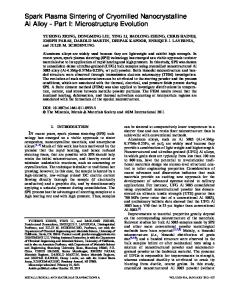Bulk nanocrystalline aluminum 5083 alloy fabricated by a novel technique: Cryomilling and spark plasma sintering
- PDF / 606,041 Bytes
- 11 Pages / 612 x 792 pts (letter) Page_size
- 28 Downloads / 326 Views
resent, there are only a limited number of fabrication methods that can be used to synthesize bulk nanocrystalline metals[1,2] that have sufficiently large dimensions for practical applications. Powder metallurgy–based consolidation methods, which can be used for this purpose, normally involve the synthesis of nanocrystalline powder and subsequent consolidation.[3] Nanocrystalline powder can be produced by numerous processing methods, such as mechanical milling, evaporation condensation, and precursor decomposition.[2,3] Mechanical milling, especially cryomilling, is an effective approach to synthesize a large quantity of nanocrystalline metallic powder. Cryomilling is normally conducted in a liquid nitrogen atmosphere, suppressing the dynamic recovery and recrystallization by the cryogenic temperature and thus facilitating grain refinement in metallic powder.[4] Cryomilling can be easily scaled up and has the potential to be economically feasible.[5] Koch[6] pointed out that two problems may occur with cryomilling: (1) the contamination from the milling media and atmosphere and (2) grain coarsening during powder consolidation. It has been demonstrated, however, that the contamination introduces impurities (e.g., Fe) and in-situ formed compounds (e.g., nitrides and oxides) that are approximately 2 to 10 nm in size and are uniformly dispersed in the cryomilled powder, resulting in greatly improved thermal stability[7] and mechanical properties.[8] In contrast, severe grain growth has been observed at room temperature in nanocrystalline Al that is free of such impurities, because it was synthesized with a chemical method.[9] Conventional consolidation of cryomilled powder can, however, lead to significant grain growth. For example, an average grain size of 116 nm was observed in a hot isostatically pressed (‘‘hipped’’) Al-Mg alloy,[10] and the grain size in a 5083 Al consolidated by cold isostatic pressing (CIP) and extrusion was 207 nm.[11] The bulk materials JICHUN YE, Graduate Student, LEONARDO AJDELSZTAJN, Research Scientist, and JULIE M. SCHOENUNG, Associate Professor, are with the Department of Chemical Engineering and Materials Science, University of California, Davis, CA 95616-5294. Manuscript submitted November 5, 2005. METALLURGICAL AND MATERIALS TRANSACTIONS A
will exhibit unique properties only if the initial nanocrystalline structure in the powder is preserved after the consolidation process. Spark plasma sintering (SPS), a relatively new sintering technique, has been demonstrated to successfully consolidate nanosized powder into a dense bulk material in a shorter time and at lower temperatures than would be required with conventional consolidation methods, both of which facilitate the retention of the fine structure in the starting materials.[12] Spark plasma sintering is a modified hot pressing technique in which pulsed DC current and uniaxial pressure are applied simultaneously. The pulsed current passes through the electrically conductive graphite die and sample, if conductive. Heating of a dielectric samp
Data Loading...











